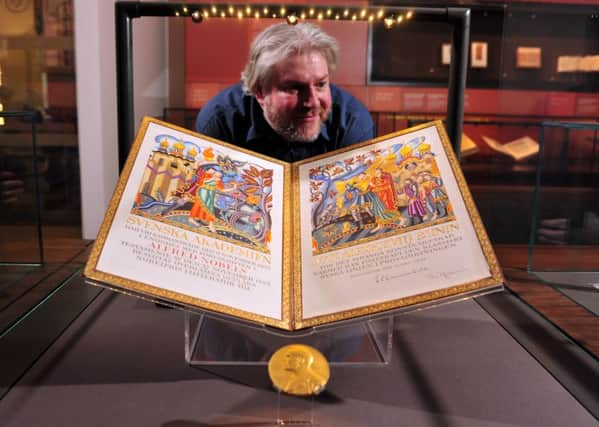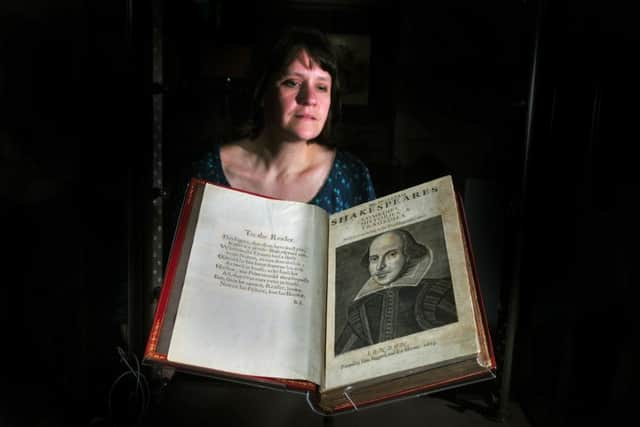The brand new Yorkshire gallery which showcases literary masterpieces


It began with a copy of Andrew Marvell’s Miscellaneous Poems. Not the grandest of titles, nor the grandest of books, but without it, one of Yorkshire’s best collections of literature may never have happened. It was back in 1922 that wealthy industrialist Edward Brotherton headed to London with the hope of bringing back a gift for his home town of Wakefield. He had his heart set on a 15th century Towneley manuscript of the Wakefield mystery plays. Unfortunately, so did a number of other investors.
Brotherton was outbid by an American book dealer, but he wasn’t outdone. Along with his niece, Dorothy Una Ratcliffe, they visited another of the capital’s booksellers and returned north with a first edition of Marvell’s poetry.
Advertisement
Hide AdAdvertisement
Hide Ad“From there the pair began collecting in earnest,” says Richard High, curator at Leeds University’s Brotherton Library. “In just four years he had acquired four 17th century Shakespeare folios and countless other rare books and manuscripts. In 1927 he donated £100,000 for the building of a new library at the university and on his death in 1930, his personal collection, which by then included more than 25,000 books, 400 manuscripts and 30,000 letters, also came into our ownership.”


Brotherton was always insistent that the library should be open to the public, so he would no doubt have approved of a new £1.9m gallery designed to showcase the best of the treasures.
“One of Brotherton’s great gifts was that he set aside money so the university could continue acquiring important works,” says Dr Stella Butler, university librarian and keeper of the Brotherton Collection. “It now means that today we have five designated collections which are deemed of international importance.”
Divided into two, the gallery has a number of items on permanent display, alongside a temporary exhibition space, which will throw the spotlight on those five collections, which range from cookery to the First World War and the Leeds-Russian archive.
Advertisement
Hide AdAdvertisement
Hide Ad“Many hours were spent choosing which items to put on display,” says Dr Butler. “But all the hard work has been worth it and I hope we know have a gallery that Brotherton would have been proud of.”


Shakespeare’s First Folio, 1623
This was perhaps the most obvious item for inclusion in the new gallery. Printed in 1623, seven years after Shakespeare’s death, the first collected edition of the Bard’s plays is widely considered to be one of the greatest books ever published and was compiled by his colleagues John Heminge and Henry Condell. The folio, which the pair said was based on “true orginall copies” contains 18 works, which had already been printed during Shakespeare’s lifetime, plus a further 18 plays. Without it, Macbeth, Twelfth Night and The Tempest may have been lost forever. The work is of particular importance because just 44 of the 228 First Folios known to have survived now remain in the UK.
Ivan Bunin’s Nobel Prize medal and certificate, 1933
The Nobel Prize panel certainly know how to pull out all the stops when it comes to their awards. Each certificate is designed individually and this one was presented to the anti-communist Bunin who was the first Russian writer to receive the award. By the time he picked up literature’s greatest prize “for following through and developing with chastity and artfulness the traditions of Russian classic prose” he was living in France where he had fled in exile some 13 years earlier. The prize was widely seen not only as an endorsement of Bunin’s artistic talent, but also as mud in the eye of his main rival Maxim Gorky, and his pro-Soviet backers.
A Booke of Cookrye, 1584
The oldest book written in English in the university’s cookery collection contains those essential 16th century recipes “to stue sparrowes or larkes” as well as the more intriguing “dish of Snowe”. Written by the anonymous A.W., and printed by John Allde in 1584, it is the only known surviving copy and includes information on “The order how meats should be served to the Table” and “The service for fish dayes”. Don’t expect to find detailed methods, cooking times, temperatures or amounts. Instead, most of the recipes run to just a couple of lines. Another edition of 1587 is also in the collection and includes a handful of additional recipes under the heading “Banquetting Stuffe”.
Advertisement
Hide AdAdvertisement
Hide AdThe works of Geoffrey Chaucer, printed by William Morris, 1896
When the 19th-century designer, social reformer and writer, William Morris founded the Kelmscott Press, his aim was simple – to revive the skills of hand printing, which mechanisation had destroyed. One of the press’s crowning glories was The Works of Geoffrey Chaucer. Bound in embossed pig skin, the book features 87 wood-cut illustrations by Edward Burne-Jones, who described the work as a “pocket cathedral – so full of design”.
Wole Soyinka, Prisonettes manuscript, 1969
Born in 1934, Soyinka studied English at the University of Leeds during the early 1950s. An active opponent of the federal government during the Nigerian Civil War, he was arrested in 1967 and spent nearly two years in solitary confinement where he wrote a number of poems. Denied equipment for writing, Soyinka memorised his short verses until he eventually found scraps of paper on which to write them down. He later said they were dedicated to all who participated in the “two-year experiment on how to break down the human mind”.
Genealogical History Roll, France, 1461-1483
The most highly-decorated item in the Brotherton’s collection, this illuminated manuscript is made from 39 pieces of parchment and stretches to more than 50ft. Produced in Paris during the reign of Louis XI (1461-1485), across the top a row of miniatures depicts the six days of the Creation. Running in columns, the rest of the content charts the Old Testament, the life of Christ, Greek and Roman history and landmarks of Western Europe.
• Treasures of the Brotherton is open Tues to Sat, 10am-5pm and Mon, 1-5pm.